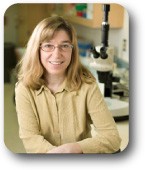
Gloria E.O. Borgstahl
Professor
Gloria E.O. Borgstahl
Professor
April 2016 Outstanding Faculty Mentor of Graduate Students Award
February 2008 Distinguished Scientist Award
Jul 2008-Present Professor with tenure; Eppley Institute for Research in Cancer and Allied Diseases
Aug 2002-Jun 2008 Associate Professor with tenure; Eppley Insititute for Research in Cancer and Allied Diseases with courtesy appointments in the Department of Biochemistry and Molecular Biology and the Department of Pharmaceutical Sciences
May 2002-Jul 2002 Associate Professor with tenure at the University of Toledo Department of Chemistry
1996-2002 Assistant Professor of Chemistry at the University of Toledo Department of Chemistry
1994-1996 Postdoctoral Fellow Los Alamos National Laboratory
1992-1994 Postdoctoral Fellow The Scripps Research Institute
Ph.D. 1992 University of Iowa in Biochemistry
B.S. Eng. 1985 University of Iowa in Biomedical Engineering
Research Interests
Research Interests
I am interested in developing novel X-ray crystallography methods and in studying the macromolecules essential to the protection of biological macromolecules and the maintenance and replication of DNA.
Lately we have developed protocols for the processing of incommensurately modulated diffraction data from protein crystals, we have studied these modulations through computer modeling and we have started to create software to refine these structures in (3+1)D superspace.
Our laboratory has had a long-standing interest in the proteins involved in DNA metabolism using X-ray crystallography and molecular modeling. In particular we study human replication protein A (RPA) and RAD52. RPA is a single-stranded DNA binding protein that is a key player in DNA metabolism and together with RAD52 anneals repetitive DNA sequences at double-strand breaks. This annealing reaction is a drug target in homologous recombination deficient hereditary cancers.
Our laboratory also has an interest in superoxide dismutase (SOD) enzymes that are critical in preventing damage to all biological macromolecules. We are investigating the catalytic mechanism by which superoxide dismutases affect oxygen radicals. We are employing neutron diffraction to solve crystal structures of SOD in order to see hydrogen positions and avoid reduction of the active site metal by x-rays. In order to obtain crystals of suitable size and purity for neutron diffraction, we grow crystals in microgravity on the international space station.
Other Interests
I bike across Nebraska every year in BRAN! And across Iowa in RAGBRAI!
